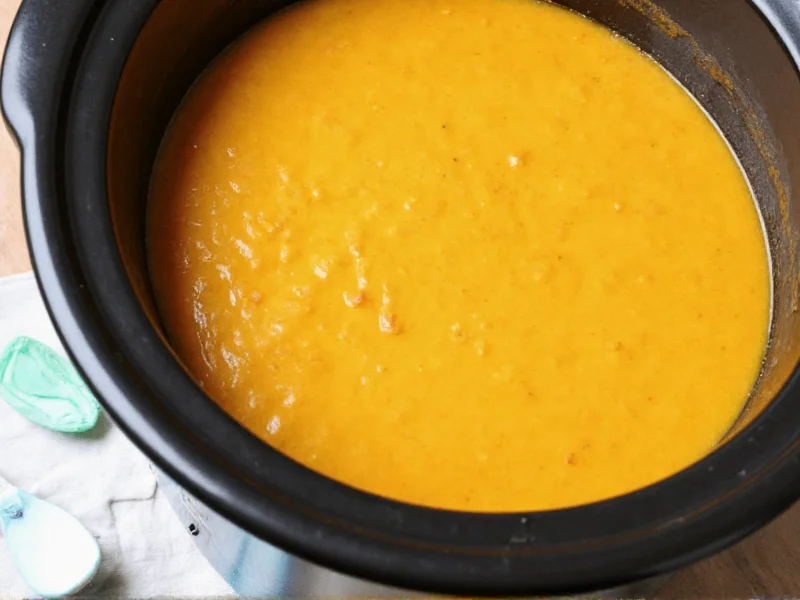Slow cooker butternut squash soup transforms humble ingredients into a restaurant-quality meal with virtually no hands-on time. Unlike stovetop versions requiring constant attention, the slow cooker method develops deeper flavors through gentle, prolonged cooking while you attend to other tasks. The magic happens as the squash breaks down completely, creating a naturally creamy texture that rivals versions made with heavy cream or coconut milk.
Why Slow Cooking Elevates Butternut Squash Soup
Butternut squash contains complex starches that need time to fully break down and develop their natural sweetness. The slow cooker's low, consistent heat (typically 175-200°F on low setting) allows enzymatic reactions to occur gradually, converting starches to sugars without scorching. This process creates a richer flavor profile compared to faster cooking methods. Professional chefs often roast squash first for depth, but the slow cooker eliminates this extra step while still delivering exceptional results.
Essential Ingredients and Their Roles
The beauty of this healthy slow cooker butternut squash soup lies in its simplicity, but each ingredient serves a specific purpose:
- Butternut squash (2-3 lbs): Choose firm, heavy specimens with no soft spots. The sugar content varies by growing conditions, so taste your squash before seasoning.
- Aromatic base: 1 large onion and 3-4 garlic cloves build foundational flavor. Yellow onions provide sweetness; red onions add complexity.
- Liquid component: 4 cups low-sodium vegetable broth (homemade preferred). Water works in a pinch but lacks depth.
- Flavor enhancers: 1 apple (for natural sweetness), 1 tsp fresh thyme, ½ tsp ground sage, pinch of nutmeg
- Acid component: 1 tbsp apple cider vinegar or lemon juice added at the end balances richness
Step-by-Step Preparation Guide
Follow these precise steps for foolproof slow cooker butternut squash soup every time:
- Prep squash: Peel, seed, and cube squash into 1-inch pieces (uniform size ensures even cooking)
- Layer ingredients: Place squash, onion, garlic, apple, and spices in slow cooker. Pour broth over top.
- Cooking parameters: Cover and cook on LOW for 6-8 hours or HIGH for 3-4 hours. Do not stir during cooking.
- Final preparation: Remove lid, add vinegar/lemon juice, then blend with immersion blender until smooth.
- Seasoning adjustment: Taste and adjust salt, pepper, and spices after blending (flavors concentrate during cooking)
| Cooking Variation | Key Ingredients | Best For |
|---|---|---|
| Creamy Vegan | 1 can coconut milk, 2 tbsp nutritional yeast | Dairy-free luxury|
| Protein-Packed | 1 cup cooked white beans, 2 tbsp tahini | Heartier meal replacement|
| Spiced Curry | 1 tbsp curry powder, ½ tsp turmeric, 1 tbsp ginger | Bold flavor lovers|
| Herb Garden | 2 tbsp fresh rosemary, 3 sprigs thyme | Spring/summer freshness
Avoiding Common Slow Cooker Mistakes
Even experienced cooks make these errors with butternut squash soup:
- Overfilling the slow cooker: Never fill beyond ⅔ capacity to prevent boil-overs and ensure proper heat circulation
- Adding dairy too early: Dairy products can curdle during prolonged cooking; add coconut milk or cream in the last 30 minutes
- Skipping the acid component: The small amount of vinegar or lemon juice isn't noticeable but balances sweetness and enhances other flavors
- Blending while too hot: Allow soup to cool slightly before blending to prevent pressure buildup and dangerous splatters
- Underseasoning: Squash requires more salt than you might expect; season in layers (before cooking, after blending, before serving)
Perfecting Texture Without Cream
Many recipes rely on cream for smoothness, but the best slow cooker butternut squash soup achieves creaminess naturally. The key is proper blending technique:
- Use a high-powered immersion blender directly in the slow cooker (remove to a heatproof container if using regular blender)
- Blend in 30-second intervals, scraping sides frequently
- For ultra-smooth texture, strain through a fine-mesh sieve after blending
- Add ¼ cup cooked white beans or cannellini beans before blending for natural creaminess and protein boost
Serving Suggestions and Pairings
Elevate your butternut squash soup from simple to spectacular with these finishing touches:
- Texture contrast: Top with toasted pumpkin seeds, croutons, or crispy chickpeas
- Flavor accents: Drizzle with chili oil, swirl of pesto, or sprinkle of fresh herbs
- Protein additions: Add shredded rotisserie chicken or cooked lentils for heartier meals
- Perfect pairings: Serve with crusty bread, kale salad, or grilled cheese sandwiches
Storage and Reheating Guidelines
This versatile soup actually improves in flavor after 24 hours as flavors meld. Follow these storage recommendations:
- Cool completely before storing (never put hot soup directly in refrigerator)
- Store in airtight containers for up to 5 days in refrigerator
- Freeze in portion-sized containers for up to 3 months
- Reheat gently on stove over medium-low heat, stirring frequently
- Add a splash of broth when reheating frozen soup to restore proper consistency











 浙公网安备
33010002000092号
浙公网安备
33010002000092号 浙B2-20120091-4
浙B2-20120091-4